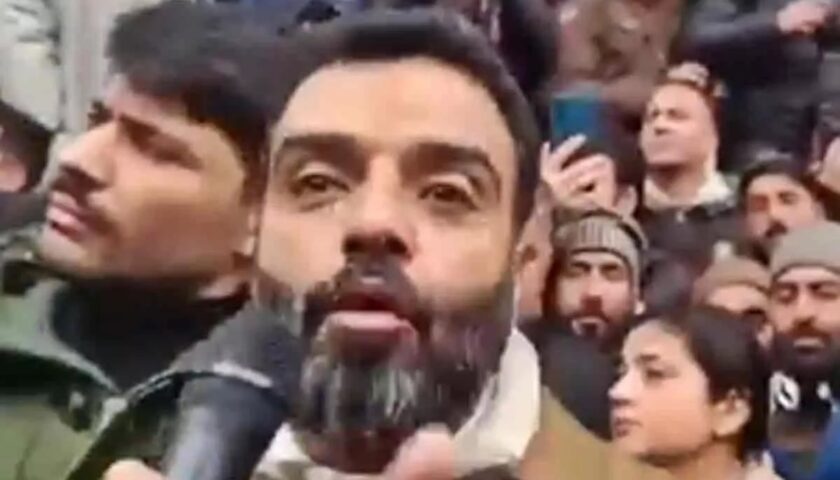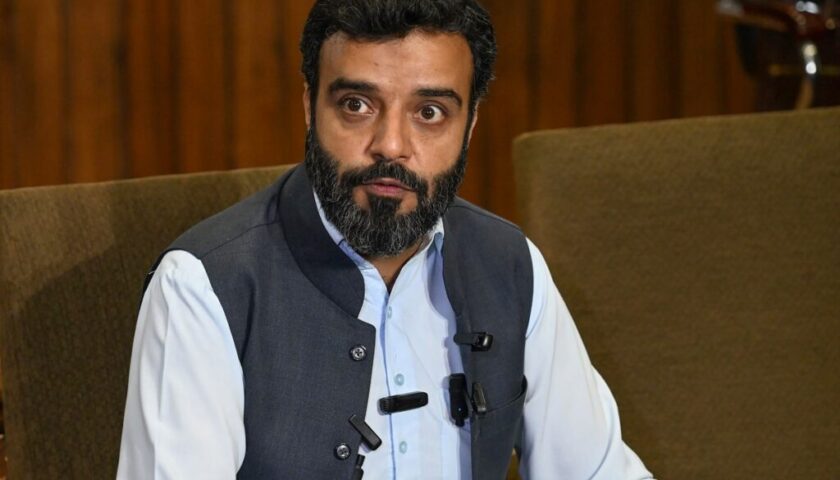Denial of Protocol to Omar Abdullah: J&K Parties Slam Amit Shah’s Jammu Visit Optics
By: Javid Amin | 03 Sep 2025
Srinagar/Jammu: Union Home Minister Amit Shah’s recent visit to flood-hit areas of Jammu has sparked a political firestorm in Jammu and Kashmir. Viral images from the visit have ignited a heated debate over protocol, respect for institutions, and the balance of power between the Union Government, the Lieutenant Governor’s office, and the elected state leadership.
At the center of the controversy is Chief Minister Omar Abdullah, who, according to critics, appeared sidelined during Shah’s visit—reduced to the role of a bystander rather than the constitutional head of an elected government.
What Happened?
On September 1, 2025, Amit Shah landed in Jammu to review flood damage near the Tawi River. Viral visuals showed Shah being briefed by Lieutenant Governor Manoj Sinha, BJP’s Leader of Opposition Sunil Sharma, and senior officials.
In the same frame, Chief Minister Omar Abdullah was seen standing at a distance, listening but not actively engaged. The optics triggered an avalanche of political reactions, with opposition leaders accusing the Centre of deliberately humiliating the state’s elected head.
Critics argue that, in a democracy, protocol and respect for elected representatives must be upheld—especially in a crisis situation where the CM’s role is pivotal.
Political Reactions
The incident quickly snowballed into a political storm, with parties across the ideological spectrum weighing in:
-
PDP’s Iltija Mufti called the visuals “deeply unfortunate” and stressed:
“Politics aside, he is an elected Chief Minister who represents all of us. A little more grace and magnanimity wouldn’t hurt.”
-
Sheikh Khursheed (Awami Ittehad Party) went further:
“Disrespect to the Chief Minister is unacceptable. It is the matter of credibility of an institution and mandate.”
-
Youth Congress’s Jai Sidh Bhalla echoed public sentiment:
“It is not his insult, it is our insult, because we were the ones who elected him.”
-
AAP’s Mehraj Malik turned the controversy into a challenge for Omar Abdullah himself:
“The Chief Minister should show self-respect and stop running behind BJP like a shadow.”
-
Former Srinagar Mayor Junaid Mattu mocked the images on social media:
“Want to test your eyesight? Can you spot our Chief Minister?”
These comments reflect a larger unease about Centre-State relations in J&K, where questions of autonomy, authority, and optics carry symbolic weight.
National Conference’s Response
The ruling National Conference (NC) dismissed the criticism as “propaganda.” Party spokespersons clarified that the viral image captured only a brief moment and that Omar Abdullah did meet Amit Shah during the visit.
However, the NC also expressed serious concern over Lt. Governor Manoj Sinha’s presence in a BJP-only meeting chaired by Shah in Jammu. Party leaders argued that:
-
The LG is a constitutional appointee, expected to maintain political neutrality.
-
His participation in a partisan meeting blurred the line between constitutional responsibility and party politics.
This nuance indicates that while the NC defended Omar Abdullah’s position, it also seized the moment to highlight institutional imbalances created after J&K’s special status was revoked in 2019.
The Larger Debate: Protocol vs Optics
The uproar isn’t just about one photograph—it reflects a larger tussle over:
-
Protocol:
-
In Indian democracy, Chief Ministers are the constitutional heads of their states. By convention, Union Ministers coordinate closely with them during official visits.
-
In this case, many saw Shah’s reliance on the LG and BJP leaders as a deliberate slight to Omar Abdullah.
-
-
Optics:
-
Politics often hinges on imagery. A CM standing silently on the sidelines while others brief the Home Minister creates a symbol of diminished authority.
-
For a region like J&K—where questions of autonomy and democratic empowerment are already sensitive—the optics carried amplified weight.
-
-
Institutional Balance:
-
The dual presence of an LG and a CM in J&K creates overlaps of authority.
-
Critics argue that until this ambiguity is resolved, protocol controversies will continue to spark political friction.
-
Why This Matters for J&K
This controversy lands at a fragile political moment in Jammu and Kashmir:
-
The region only recently saw the restoration of statehood after years of direct central rule.
-
The elected government is still trying to assert its authority while sharing space with the LG’s office, which continues to wield considerable power.
-
For the public, the optics of their CM being sidelined reinforces perceptions that New Delhi holds the real control, while elected representatives are secondary.
Such incidents risk eroding public confidence in democratic institutions, especially in a state where faith in political processes has been tenuous since the abrogation of Article 370.
Beyond the Photo: A Symbol of Uneasy Relations
To some, the viral image of Omar Abdullah standing quietly by the Tawi River is just that—a fleeting photo. But to others, it is a symbol of how J&K’s elected leadership continues to be overshadowed by central figures and constitutional appointees.
The opposition has successfully turned this episode into a talking point about respect, autonomy, and democratic dignity—issues that resonate deeply in J&K’s political psyche.
History of Protocol Disputes in Jammu & Kashmir
Protocol tussles are not new to Jammu and Kashmir. The region’s unique constitutional history, complex Centre–State relations, and dual structures of authority (Governor/LG vs Chief Minister) have often led to embarrassing breaches, symbolic clashes, and public controversies.
The Sheikh Abdullah Era (1947–1953)
-
In the early years after Independence, Sheikh Mohammad Abdullah, the “Lion of Kashmir,” enjoyed near-sovereign status under Article 370.
-
However, protocol disputes surfaced even then, particularly over who represented J&K in official functions—the Prime Minister of J&K (Sheikh Abdullah) or the Governor/President of India’s nominee.
-
Sheikh often insisted on being treated as the sole legitimate authority within J&K, refusing to let Delhi-appointed officials overshadow him.
-
This tension was one of the many triggers that led to Sheikh’s dismissal and arrest in 1953, a moment many still recall as the first protocol humiliation of an elected Kashmiri leader.
The 1980s: Farooq Abdullah vs Jagmohan
-
Perhaps the most famous series of protocol disputes occurred in the 1980s, during the turbulent relationship between CM Farooq Abdullah and then Governor Jagmohan Malhotra.
-
Jagmohan frequently bypassed the elected government, taking decisions directly, especially on law and order.
-
Public events often saw Farooq sidelined, with the Governor assuming a commanding role.
-
This culminated in 1984, when Jagmohan’s behind-the-scenes maneuvering led to Farooq Abdullah’s dismissal as CM, citing “loss of majority.”
-
For many in J&K, this episode cemented the image of New Delhi undermining elected leaders under the guise of protocol and constitutional powers.
The 1990s: Governors in Command
-
During the peak of militancy in the 1990s, J&K was under Governor’s Rule and President’s Rule for long stretches.
-
Protocol disputes effectively disappeared, because the Governor became the de facto executive.
-
However, when elected governments briefly returned (e.g., Farooq Abdullah’s NC in 1996), tensions resurfaced.
-
Security reviews and high-level meetings were often chaired by Delhi-appointed Governors rather than the elected CM, reinforcing the perception that real power lay outside the Assembly.
The Mufti & PDP-Congress Era (2002–2008)
-
When Mufti Mohammad Sayeed became CM in 2002, protocol disputes again made headlines.
-
Delhi’s central security agencies frequently reported directly to the Governor, bypassing the CM’s office.
-
Mufti often complained—both publicly and privately—that his authority was being diluted in the eyes of both citizens and bureaucracy.
-
Yet Mufti tried to spin this as a “healing touch” strategy, arguing that elected institutions must be respected to rebuild trust.
Omar Abdullah’s Earlier Embarrassment (2009)
-
Ironically, Omar Abdullah—now at the center of the 2025 controversy—faced a major protocol humiliation in July 2009.
-
Then Home Minister P. Chidambaram held a high-level security meeting in Srinagar but initially failed to inform or invite Omar Abdullah, who was the sitting CM.
-
Omar was reportedly furious, and the NC accused Delhi of treating the state government like a junior partner rather than an equal stakeholder.
-
That incident mirrors today’s controversy: a Union Home Minister visiting J&K, but the CM being sidelined in decision-making optics.
The BJP-PDP Coalition Era (2015–2018)
-
The uneasy alliance between Mehbooba Mufti’s PDP and the BJP was also riddled with protocol disputes.
-
Mehbooba frequently clashed with the then Governor N.N. Vohra, complaining that her government was “undermined by Raj Bhavan.”
-
On several occasions, BJP ministers from Delhi held closed-door strategy meetings in Jammu or Srinagar, where Mehbooba was either not present or invited only perfunctorily.
-
Mehbooba often framed these exclusions as “disrespect to the people’s mandate.”
Post-2019: Abrogation of Article 370 and the LG’s Ascendancy
-
After Article 370 was abrogated in August 2019, J&K lost its statehood and was reduced to a Union Territory with an LG in charge.
-
From then until 2024, there was no elected CM—only the LG held authority.
-
During this phase, protocol was entirely LG-centric, as Union Ministers, including Amit Shah and the PM, coordinated directly with LG Manoj Sinha.
-
Many analysts argue this period normalized the sidelining of elected leaders, making the Omar Abdullah episode in 2025 appear as a continuation of this legacy.
What This History Shows
Looking back, the “denial of protocol” controversies reveal a pattern:
-
Recurring Tension:
Whenever J&K has had an elected CM, there have been clashes with the Governor/LG or Union ministers over status, authority, and optics. -
Symbolic Undermining:
These disputes aren’t just about seating arrangements or photo frames—they represent power struggles over who controls the narrative in Kashmir. -
Public Sensitivity:
In J&K, where trust in institutions has been fragile, every instance of sidelining an elected CM is seen as an attack on democracy itself, not just an individual.
What Lies Ahead?
Moving forward, three things are worth watching:
-
Centre-State Relations: Whether the Union Government makes a conscious effort to restore protocol and respect to the CM’s office during future visits.
-
LG’s Role: Growing pressure on constitutional appointees like the LG to maintain strict neutrality.
-
Opposition Strategy: Whether opposition parties can sustain this controversy into a larger narrative of political disempowerment in J&K.
Bottom-Line
The controversy over Amit Shah’s Jammu visit is more than just about Omar Abdullah’s protocol. It speaks to the soul of democracy in Jammu and Kashmir—where elected leaders are still struggling to reclaim their space in the shadow of central authority.
In a region where symbols matter as much as substance, the image of a sidelined Chief Minister has become a powerful reminder of the unfinished journey toward democratic restoration.




